Ever wondered how to write a CV UK employers will actually notice?
It’s wild to think that almost a third of companies now use AI to screen applications before a human even looks at them. That means your CV has to impress both robots and real people — fast.
Your CV isn’t your job. It’s your ticket to an interview — your one chance to say, “Hey, I’m worth meeting.” Recruiters only spend a few seconds scanning each application, so making your CV stand out in 2025 is all about clarity, structure, and a sprinkle of personality.
Most experts agree that a UK CV should be short and sharp — ideally one to two pages. If you’re a student or new to the workforce, one page usually does the trick. For senior professionals with decades of experience, two (sometimes three) pages is perfectly fine.
The reverse chronological format is still the go-to in 2025, but there are moments when a skills-based layout can be your secret weapon. The key is knowing which one suits your situation best.
In this guide, I’ll walk you through everything — from understanding what makes a strong UK CV to choosing the right format and avoiding easy mistakes. Whether you’re a graduate applying after finishing at one of the best universities in London or switching careers later in life, these simple steps will help you stand out in today’s competitive job market.
Understand What Makes a Good CV in the UK
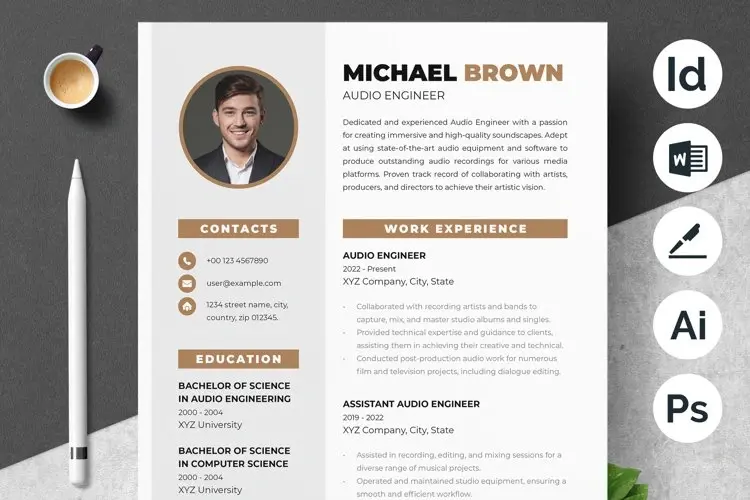
Image Source: Design Bundles
In the UK job market, understanding what constitutes a strong CV is essential for job-hunting success. A curriculum vitae (CV) serves as your first opportunity to promote yourself to potential employers, and making it stand out requires attention to specific British expectations.
What Makes a Good CV UK Employers Actually Want to Read
A CV isn’t just a list of jobs — it’s a story about who you are professionally. In the UK, that story needs to be short, relevant, and easy on the eyes.
A strong CV follows one golden rule: make it easy to scan. Recruiters love clear, tidy layouts with simple fonts like Arial, Calibri, or Times New Roman in size 11 or 12. Keep margins even, use headings that pop, and avoid walls of text.
Here’s what every UK CV should include:
- Contact details: Full name, phone number, email, and LinkedIn (if it’s professional).
- Personal statement: A short summary about who you are and what you offer.
- Work experience: List your jobs in reverse order — latest first — focusing on achievements.
- Education: Include your qualifications, grades, and any relevant modules or projects.
- Skills: Combine technical know-how with interpersonal strengths.
- Extras (optional): Languages, volunteering, or certifications that make you memorable.
When writing, use active verbs like created, managed, and delivered instead of vague words like helped or involved in. Avoid tired phrases such as “hardworking team player.” Instead, show proof: “Led a three-person team to deliver a marketing campaign that grew website traffic by 40%.” That’s the kind of detail that sticks.
Why UK CVs Are Different (and Why It Matters)
If you’ve ever searched “how to write a CV UK vs resume,” you’ll know there’s plenty of confusion.
In Britain, we use the term CV (curriculum vitae), while the US and Australia say résumé. They might look similar, but UK CVs have their own quirks.
Here’s the biggest difference: UK employers don’t want personal details or photos. Leave out your age, date of birth, marital status, and nationality — these aren’t relevant here and can even break equality guidelines.
Another thing? UK CVs tend to be a bit longer than US résumés. A British CV often tells your professional story over one or two pages, while a US résumé is usually a single, punchy page focused on your latest role.
Basically, your UK CV should show the whole picture — a clear journey from where you started to where you are now, without getting bogged down in irrelevant extras.
When to Use a CV vs a Resume (And Which One You Need)
In the UK, CV and résumé usually mean the same thing — but there’s one exception.
If you’re applying for an academic or research role, you’ll need a longer academic CV (three to ten pages). This version includes things like publications, conferences, and grants.
For most UK job applications, though, a one- to two-page employment CV is standard.
If you’re applying abroad, remember that a US CV actually means an academic résumé. Confusing, right? Always check the local expectations before hitting send.
By tailoring your CV for UK employers — and keeping it relevant to the market — you’ll instantly boost your chances of landing that interview.
And if you’re looking for a new start this year, you might also enjoy my guide on how to improve your credit score — perfect if you’re planning to relocate or budget between jobs.
Choose the Right CV Format for 2025: What Recruiters Actually Want
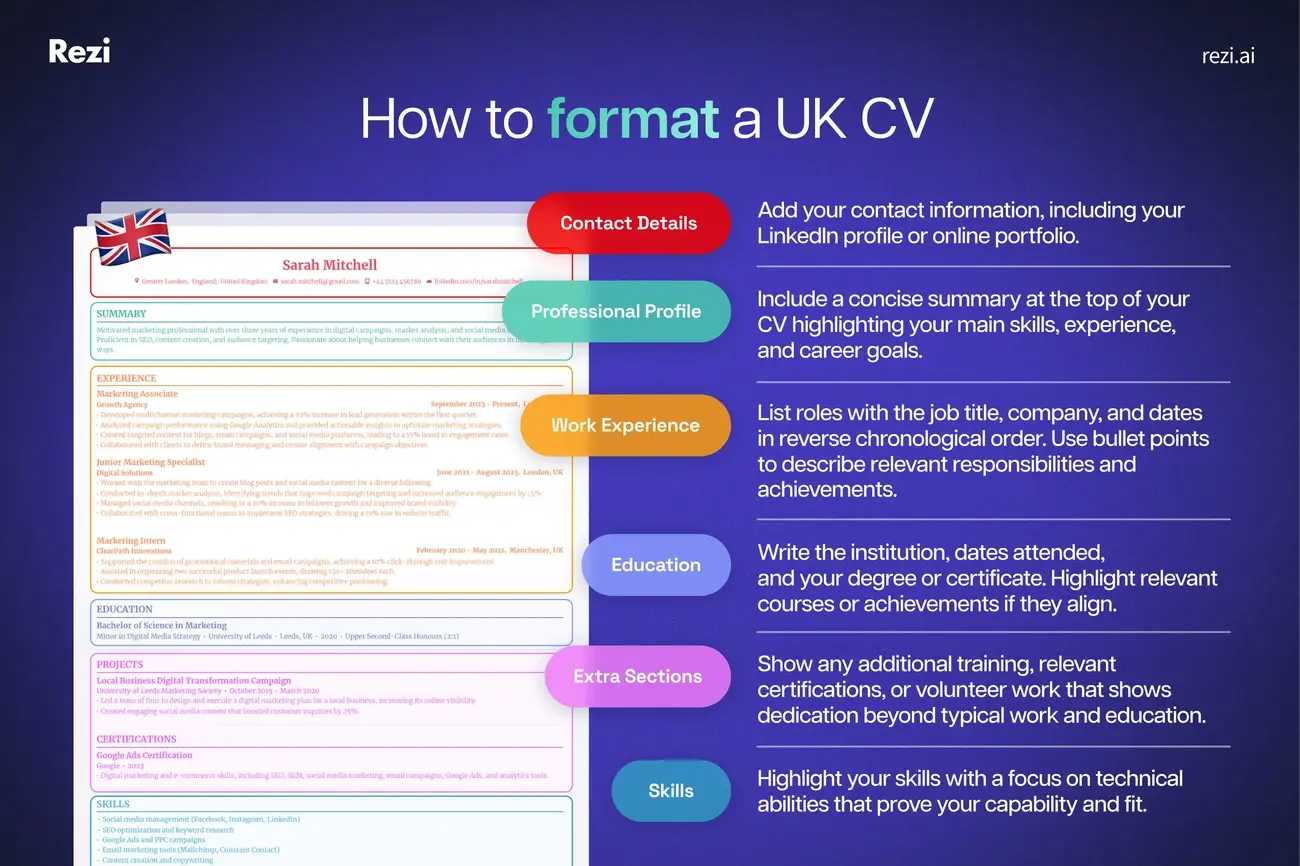
Image Source: Rezi AI
Choosing the right structure is one of the biggest secrets behind how to write a CV UK employers love. The format decides how your story is told — and how easy it is for someone to see why you’re perfect for the job.
In 2025, recruiters are spoilt for choice. Some still prefer the classic reverse chronological CV, while others welcome skills-based CVs — especially for people switching careers or just starting out.
Let’s unpack which format works best for you.
Reverse Chronological CV: The Classic That Still Wins
The reverse chronological CV is the old-school favourite that remains the most popular format in the UK — and for good reason.
It lists your experience from the most recent job down to your earliest. This helps employers quickly spot your career growth and most relevant experience first.
It’s ideal if you’ve had:
- A steady career path in one industry
- Several years of continuous experience
- Clear job progression without major gaps
Here’s what makes it shine: it’s easy to follow, recruiter-friendly, and perfect for showcasing results.
If you’ve worked your way up within the same field, this layout lets your achievements tell the story naturally — no gimmicks needed.
Skills-Based CV: The Format for Career Changers and Graduates
If you’re early in your career, taking a break, or jumping industries, a skills-based CV could be your best friend.
This format focuses on what you can do rather than where you’ve worked. Instead of listing jobs first, you highlight your strongest skills (like leadership, communication, or coding) and then back them up with short examples.
It works beautifully for:
- Career changers moving into a new field
- Graduates or entry-level applicants with little experience
- Professionals returning to work after a break
- Freelancers with project-based or short-term roles
Basically, it helps you focus the reader’s attention on your abilities rather than the gaps on your timeline — a great trick in today’s competitive job market.
When and How to Use Each Format
Choosing between the two depends on your situation.
Go with reverse chronological if you want to:
- Show career growth
- Highlight your most recent roles
- Present a clear, traditional structure recruiters expect
Choose skills-based if you want to:
- Emphasise transferable skills
- Mask employment gaps
- Shift careers or re-enter the workforce
Interestingly, a 2025 survey found that 74% of UK recruiters don’t mind if your CV stretches beyond two pages — as long as it’s relevant and well-structured. That’s your permission to relax a little on page limits, especially if you have achievements worth mentioning.
But remember: every word must earn its place. Keep your CV concise, avoid repetition, and tailor it to the exact job description. Including keywords from the listing will help you get through AI screening tools and Applicant Tracking Systems (ATS).
How Long Should a CV Be in the UK? (2025 Guidelines)
Here’s a quick rule of thumb:
- Graduates & entry-level applicants: One page is usually perfect. Add key modules, university projects, and volunteer experience.
- Mid-level professionals: Two pages — detailed but focused on your last 10 years. Mention only older roles if they’re relevant.
- Senior professionals: Two to three pages max. Include leadership experience and big wins, but keep it easy to skim.
Special fields like medicine or academia are the exception. Academic CVs can run 5–10 pages with research, publications, and grants — but that’s a niche case.
No matter your level, your CV should be tailored every single time you apply. A one-size-fits-all document doesn’t cut it anymore.
If you’re updating your professional documents, it’s a bit like giving your home a refresh — the little details matter. Think of it like bleeding a radiator — one small step can make everything run more smoothly.
Step-by-Step Guide: How to Write a CV UK Employers Can’t Ignore
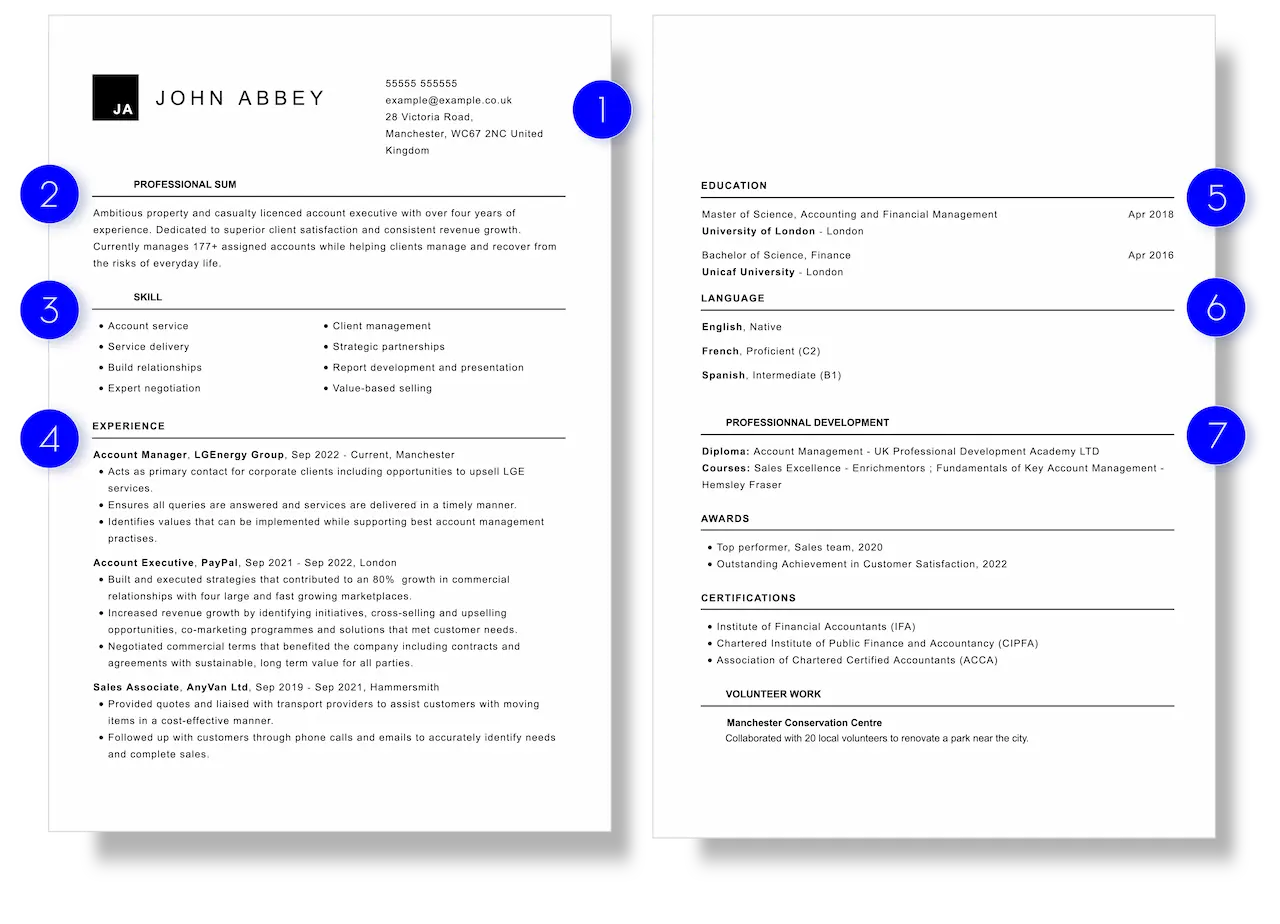
Image Source: CVHelp
So, you’ve got your format sorted. Now let’s dive into the fun part — actually writing your CV.
I know it can feel intimidating staring at a blank page (or screen), but once you break it down, it’s surprisingly straightforward. Think of it like building a story about your career — short, sharp, and full of proof that you’re the person worth calling for that interview.
Here’s exactly how to write a CV UK employers will love, section by section.
Step 1: Start with Clear Contact Details
Let’s begin with the basics — your name, phone number, email address, and city.
Keep it simple and professional. Use a sensible email (no nicknames or old Hotmail addresses) and make sure every detail is correct. You’d be surprised how many people miss out on opportunities because of one tiny typo in their email.
You can also include your LinkedIn profile or a personal website if they show off your professional side. But skip personal info like your age, marital status, or photo — UK employers don’t need it and most prefer not to see it.
Your contact details should sit right at the top of the page, easy to spot at a glance.
Step 2: Write a Personal Statement That Hooks Them
Your personal statement is your elevator pitch — a short, confident intro that explains who you are, what you bring, and what you’re looking for.
Keep it to about 100–150 words. Start strong, be specific, and skip buzzwords.
Here’s a quick formula that always works:
“I’m a [your role] with [X years] of experience in [industry/skills]. I specialise in [your main strengths] and I’m passionate about [goal related to the job].”
For example:
“I’m a creative marketing assistant with two years of experience in digital campaigns. I’m skilled in content creation, social media strategy, and photo editing — and I love finding fresh ways to tell stories that connect.”
See? Short, direct, and full of confidence — that’s the kind of energy that gets noticed.
Step 3: Add Work Experience That Shows Results
This is where most people get it wrong — they list responsibilities instead of results.
When writing your work history (in reverse order), make sure each role includes:
- Job title
- Company name
- Employment dates
- 2–3 short lines about your role
- 2–3 bullet points with measurable achievements
For example:
- Managed a social media campaign that boosted engagement by 40% in three months.
- Trained two new staff members to use a new CRM system.
- Created product descriptions that increased online conversions by 15%.
This approach proves your value — and numbers always catch a recruiter’s eye.
Step 4: Include Education and Qualifications
List your highest qualification first, then work backwards. Include your degree or diploma, institution name, and completion dates.
If you’re a recent graduate, you can also add relevant modules, research projects, or dissertations. It helps to show your subject expertise and practical skills — especially if your work experience is still growing.
As your career develops, you can shorten this section and focus on your achievements instead.
If you’re still studying or applying for graduate roles, you might also want to check out my list of best universities in London to see how yours compares.
Step 5: Highlight Skills and Certifications That Matter
Your skills section is your secret weapon — especially for beating those AI screening systems.
Include a mix of hard skills (like Excel, Photoshop, or coding) and soft skills (like teamwork or communication). Aim for 5–10 skills that match the job description exactly.
If you hold certifications, list:
- Full certification title
- Issuing organisation
- Date earned and expiry (if relevant)
For example: “Google Analytics Certified, 2024 (Google).”
If you’ve got a professional licence or qualification that’s a key part of your role, make sure it’s high up on your CV.
Step 6: Add Optional Sections That Make You Stand Out
This is where you can add a bit of personality.
Optional extras include:
- Languages: List proficiency levels honestly (e.g., “Fluent in Spanish, conversational French”).
- Volunteer work: Perfect if it ties into your career goals or shows leadership.
- Projects: Great for creative or tech roles — include links or short descriptions.
- Memberships: Any professional bodies or societies related to your field.
These sections can make a huge difference, especially if you’re early in your career or changing industries.
They show employers that you’re proactive, engaged, and genuinely passionate about what you do — not just chasing a paycheck.
Final Tip: Tailor Every CV You Send
Here’s the truth: there’s no one-size-fits-all CV anymore.
Every role has different priorities — so tweak your CV each time to match the job description. Use the same keywords they use in the advert (naturally, not awkwardly). That’s how you get past both the AI filters and the human ones.
Once you’ve got your final version, give it one last read before sending. Then celebrate — because writing a CV that truly represents you is no small feat!
If you’re prepping for interviews next, you might also like my post on best shopping in London — perfect if you need to refresh your wardrobe with something smart but affordable before the big day.
Tailor and Optimise Your CV for Every Job in 2025
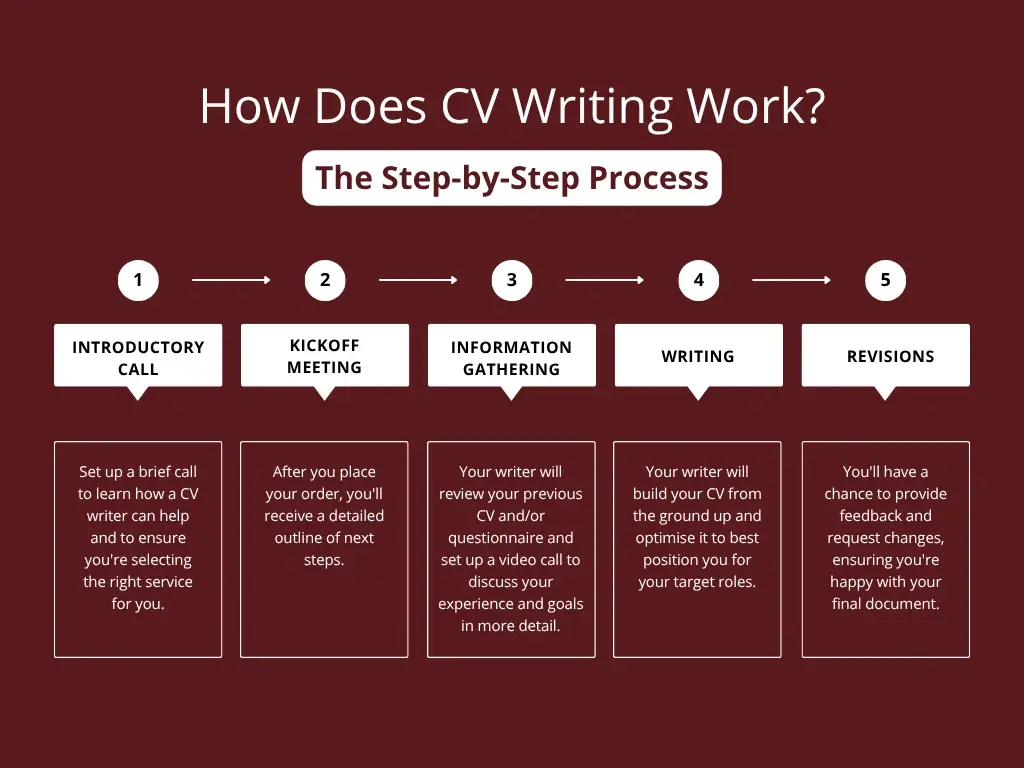
Image Source: CV Pilots
Here’s the truth: sending the same generic CV to every employer won’t get you far.
If you really want to know how to write a CV UK recruiters will notice, you have to tailor it for each job. Every role is different — and showing you understand what that company needs makes all the difference.
Before you hit send, take ten minutes to tweak your CV for the specific role. It’s the easiest way to stand out in today’s competitive job market.
How to Write a Good CV UK Recruiters Love (For Specific Roles)
Start by studying the job description closely — every line tells you what the employer truly values.
Look for:
- Key responsibilities mentioned in the ad
- Skills the company repeats (those are the gold)
- Industry language or tools they highlight
Then, match your own experience to those needs. Shuffle your content so the most relevant details appear right at the top of page one. Even if your experience comes from a uni project, part-time job, or freelance gig — if it’s relevant, it belongs there.
Remember, relevance beats length every time.
Use the Right Keywords to Beat the Bots
Most UK employers now use Applicant Tracking Systems (ATS) to scan CVs. These tools look for specific keywords — the same ones used in the job posting.
Here’s how to get past them:
- Mirror the exact words from the job description.
- Use industry-specific terms and job titles.
- Sprinkle keywords naturally through your skills, work experience, and personal statement sections.
- Avoid “keyword stuffing.” It looks fake and is easy for hiring systems (and humans) to spot.
If you’re into tech tricks, some AI tools can even scan the job description for you and suggest the right terms to include. But remember — tools can guide you, not replace you. The final voice and personality should always be yours.
Replace Generic Phrases with Real Proof
The fastest way to lose a recruiter’s attention? Filling your CV with clichés.
Phrases like “team player” or “hardworking” mean nothing without examples. Instead, show what you did and what changed because of it.
✅ Say this: “Organised a charity fundraiser that raised £2,000 for local schools.”
🚫 Not this: “Good organiser with great teamwork skills.”
Always link your actions to measurable results — it’s proof you’re someone who delivers.
Avoid Common CV Mistakes and Handle Gaps Like a Pro
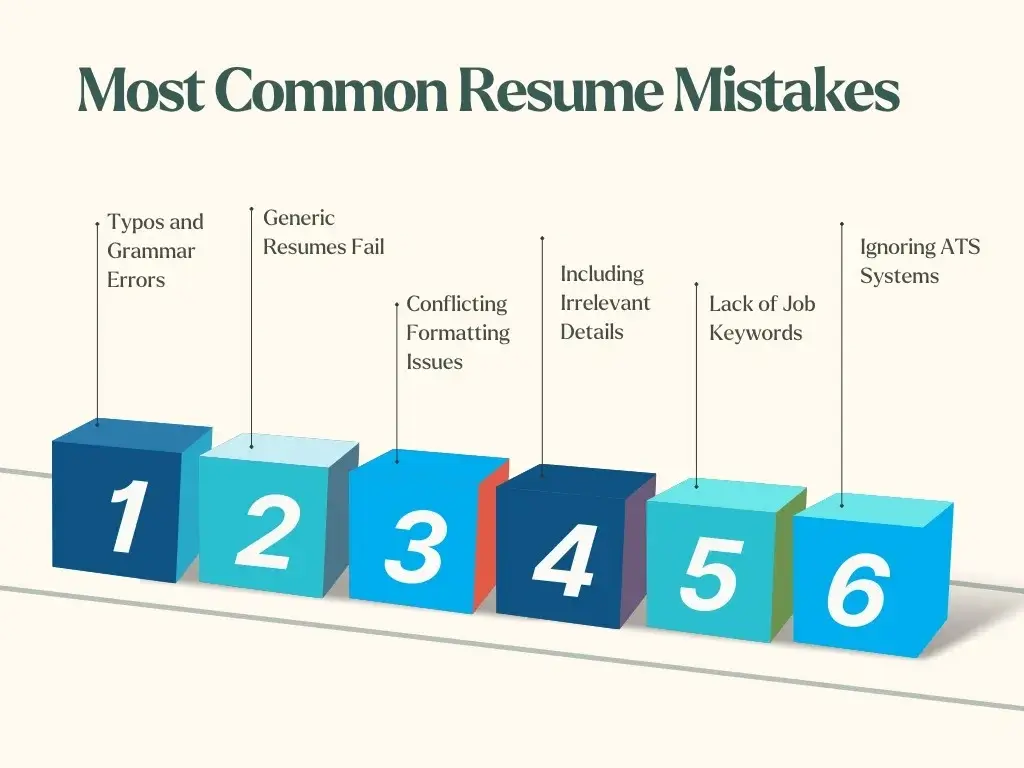
Image Source: BY Assignment Expert
Even the smallest typo can ruin a brilliant application. In fact, almost nine in ten UK executives say spelling and grammar mistakes are their biggest red flag.
Let’s fix that before your CV goes anywhere near a recruiter’s inbox.
The Most Common CV Mistakes to Avoid
Here are the blunders I see time and time again:
- Typos and grammar errors (yes, even small ones count).
- Weird fonts or messy formatting.
- CVs that are either way too short or painfully long.
- Outdated or wrong contact details.
- Copy-paste content that sounds robotic.
- Overused phrases like “responsible for” or “motivated individual.”
Always triple-check your spelling — or better yet, get a friend to proof it. A fresh pair of eyes can spot what you’ve stopped seeing.
How to Explain Employment Gaps Without Stress
Gaps happen. Life happens. And thankfully, UK employers get that.
If you took time off for health reasons, travel, or family, keep it brief and professional. Try: “Took a short career break for personal reasons, now ready to return to work.”
If redundancy was involved, focus on what you learned or did next — maybe upskilling, volunteering, or freelance projects. Those things count.
In your cover letter, you can expand a little more — but never feel like you need to overexplain. The goal is to show confidence and honesty, not defensiveness.
Proofreading and Final Checks: Don’t Skip This Step
You’ve crafted your perfect CV — now it’s time for the final polish.
Here’s my routine before I send any important document:
- Step away for an hour (a fresh brain spots more mistakes).
- Print it out and read it aloud.
- Highlight awkward phrases or repeated words.
- Ask someone you trust to review it too.
This last step matters more than you think — someone else might catch small formatting quirks or spelling slips you’ve stopped noticing.
Conclusion: Craft a CV That Opens Doors in 2025
Writing a great CV isn’t just about listing jobs — it’s about telling your story clearly and confidently.
Your goal is simple: to make the recruiter’s job easy. They should look at your CV and instantly think, “This person gets it.”
Keep your layout tidy, your wording active, and your tone professional yet human. Whether you use a reverse chronological format or a skills-based one, the magic is in tailoring it to every role.
Remember — your CV isn’t just a document; it’s your professional passport. It represents you when you’re not in the room, so make it count.
And once you’ve perfected your CV, why not reward yourself with a day off? A bit of relaxation at one of the best beaches in the UK might just be the motivation you need before your next big career move.
FAQs About Writing a CV UK in 2025
Q1. What are the key elements of a strong UK CV?
A solid CV includes your contact details, personal statement, work experience with achievements, education, and relevant skills. Optional extras like languages or projects can also help you stand out.
Q2. Should I use a chronological or skills-based CV format?
Go chronological if you’ve got steady experience in one field. Use a skills-based CV if you’re changing industries or have gaps. Both work — the key is matching your format to your story.
Q3. How can I make my CV stand out in 2025?
Tailor every CV, use keywords naturally, and highlight achievements with numbers. Add a personal touch through your statement and keep it concise — one to two pages max.
Q4. How do I handle employment gaps?
Be honest and brief. Focus on any learning, volunteering, or personal development you did during that time. Employers appreciate honesty more than overexplaining.
Q5. What are the biggest CV mistakes to avoid?
Spelling mistakes, poor formatting, false information, outdated contact details, and irrelevant personal info. Keep it clean, consistent, and job-specific.



